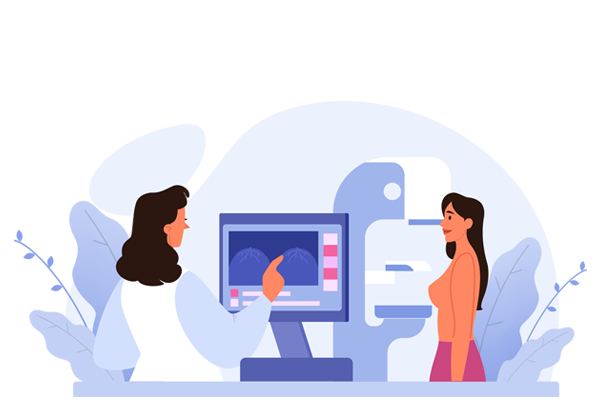
Mammography
Breast Cancer and it's Screening
In India, breast cancer is most common cancer in the females. In 2020 it has accounted for 13.5% (1,78,361) of all cancer cases and 10.6% (90,408) of all cancer deaths. Hence it is imperative to be aware of its occurrence and develop the tools for early detection and reducing the mortality.
Hence the breast cancer screening regimen is developed as follows –
Self Breast Examination
Examination by the doctor
Mammography (Breast X-Ray)
Breast Ultrasound

What is Breast self-examination and how it’s done ?
Breast self-examination is a screening method used in an attempt to detect early breast cancer. The method involves the woman herself looking at and feeling each breast for possible lumps, distortions or swelling. Its done in 2 stages.
Stage 1 – Visual Examination
Sit or stand shirtless and braless in front of a mirror with arms at your sides. To inspect breasts visually, do the following:
- Face forward and look for puckering, dimpling, or changes in size, shape or symmetry.
- Check to see if nipples are turned in (inverted).
- Inspect breasts with hands pressed down on hips.
- Inspect breasts with arms raised overhead and the palms of hands pressed together.
- Lift breasts to see if ridges along the bottom are symmetrical.
If you have a vision impairment that makes it difficult for you to visually inspect your breasts, ask a trusted friend or a family member to help you.
Stage 2 – Physical Examination
Common ways to perform the manual part of the breast exam include:
- Lying down.
- In the shower.
Tips to Keep in Mind
- Use the pads of fingers.
- Use different pressure levels.
- Take your time.
- Follow a pattern.
Stage 3 – Contact your doctor if there are any following changes : –
- A hard lump or knot near underarm.
- Changes in the way breasts look or feel, including thickening or prominent fullness that is different from the surrounding tissue.
- Dimples, puckers, bulges or ridges on the skin of breast.
- A recent change in a nipple to become pushed in (inverted) instead of sticking out.
- Redness, warmth, swelling or pain.
- Itching, scales, sores or rashes.
- Bloody nipple discharge.
What is mammography and why it is done?
Mammography is the process of using low-energy, low dose X-rays to examine the human breast for diagnosis and screening.
The goal of mammography is the early detection of breast cancer, typically through detection of characteristic masses or microcalcifications.
Hence it is used as both screening and the diagnostic test for the breast cancer for the women over 40 years of the age.
Difference between Conventional Mammography and Digital Mammography?
Both these techniques use X-ray radiation source to produce an image of the breast.
Conventional mammograms are obtained using X-Ray films/cassettes, and stored as well as read on films. There is no option to enhance, magnify or change the image on the film. These images can be digitised using the machine algorithms and post processing.
Digital mammograms are acquired, formatted, stored and read in digital formats from start and are stored on a computer (image reader) so the data can be enhanced, magnified, or manipulated for further evaluation. These images are crisper as there is no loss data as in the case of the conventional images digitised later on.
What is Tomosynthesis
In conventional digital mammography single image of the breast is acquired.
In Tomosynthesis, a full-field digital mammography system acquires multiple projection images of the breast. The X-ray tube moves through a 50° arc above the stationary detector, acquiring an image every two degrees for a total of 25 images.
Mammography Machine of Akshay Diagnostic Center Sangli
Akshay diagnostics has the state of the art Siemens Mammomat Digital Mammography machine which is the FIRST IN THE WESTERN MAHARASHTRA.
Few silent features are as follows
- Tomosynthesis is more advanced and detailed imaging technique than traditional mammography. A traditional mammogram only captures a 2-D image.
- Tomosynthesis can look at multiple layers of the breast in a 3-D image, filling in the gaps that traditional mammograms have.
- 25 images are taken instead of single image in machines without tomosynthesis.
Benefits
- More Accurate – 43% higher invasive cancer detection rate. All these images can be scrolled like CT/ MRI scan, hence very small cancers are also easily detected.
- Human centric – Personalized dose and compression.
- Efficient screening – with acquisition of up to 10 exams/ hour and faster reading.
What is ultrasound breast?
Breast ultrasound is the use of medical ultrasonography to perform imaging of the breast. It can be considered either a diagnostic or a screening procedure. It may be used either with or without a mammogram.
A type of ultrasound examination to measure tissue stiffness, which is used to detect tumours, is called Breast Elastography.
FNAC (Fine Needle Aspiration Cytology) test for breast
FNAC is a reliable, fast and accurate diagnostic method for the assessment of breast lumps. It has very few, easily manageable complications and can be done on outpatient basis.
In this test very fine needle is inserted in the breast lesion to be examined after giving the local anaesthesia and making the area aseptic under the ultrasound guidance or the needle can be inserted by palpating the lesion if its very superficial. The tissue obtained is then sent to the laboratory to look for the cancer cells.